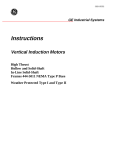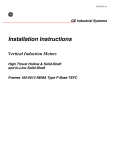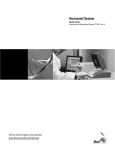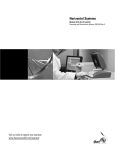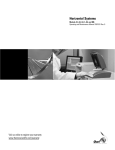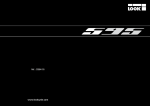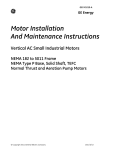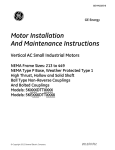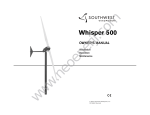Download GE gei-m1031 Installation and Maintenance Manual
Transcript
GEI-M1031-B GE Energy Motor Installation and Maintenance Instructions Horizontal AC Small Industrial Motors NEMA 143-326 Frame Totally Enclosed Fan Cooled Severe Duty, Energy Saver Models – 5KSxxxSTExxx 2012/08/24 GEI-M1031-B Table of Contents Subject I. II. III. IV. V. VI. VII. VIII. IX. Page General Information……………………………………………………………………………………………………………………………………………………………………3 A. How to Properly use this Instruction Manual………………………………………………………………………………………………………………..3 B. Safety Symbol Legend…………………………………………………………………………………………………………………………………………………………3 C. Safe Motor Operation………………………………………………………………………………………………………………………………………………………….4 Receiving, Storage, Handling and Unpacking .......................................................................................................................................... 5 A. Receiving............................................................................................................................................................................................................. 5 B. Storage ................................................................................................................................................................................................................ 5 C. Handling .............................................................................................................................................................................................................. 5 D. Unpacking .......................................................................................................................................................................................................... 6 E. Description of Labels and Nameplates……………………………………………………………………………….……………………………………….6 F. Model and Serial Numbers………………………………………………………………………………………………………………………………………………6 Installation ................................................................................................................................................................................................................... 7 A. Location ............................................................................................................................................................................................................... 7 B. Mounting ............................................................................................................................................................................................................. 7 C. Alignment .......................................................................................................................................................................................................... 7 1. Direct Coupling ....................................................................................................................................................................................... 7 2. End-Play Adjustment........................................................................................................................................................................... 8 3. Belt Drive ................................................................................................................................................................................................... 8 D. Power Supply and Connections .............................................................................................................................................................. 9 1. Wiring and Grounding ........................................................................................................................................................................ 9 2. Allowable Voltage and Frequency ............................................................................................................................................ 10 3. Position of the Conduit Box .......................................................................................................................................................... 10 Operation .................................................................................................................................................................................................................. 10 A. Prior to Starting ............................................................................................................................................................................................ 10 B. Insulation Resistance ................................................................................................................................................................................ 10 C. Steps Prior to Initial Start ......................................................................................................................................................................... 11 D. Initial Start ....................................................................................................................................................................................................... 12 E. Jogging and Repeat Starts ..................................................................................................................................................................... 12 F. Heating ............................................................................................................................................................................................................. 12 Maintenance ....................................................................................................................................................................................................... 13 A. General Cleanliness .................................................................................................................................................................................... 13 B. Insulation and Windings .......................................................................................................................................................................... 13 1. General .................................................................................................................................................................................................... 13 2. Vacuum and Compressed Air Cleaning ................................................................................................................................. 13 3. Cleaning with Water and Detergent ........................................................................................................................................ 14 4. Cleaning with Solvents .................................................................................................................................................................... 14 5. Revarnishing Windings ................................................................................................................................................................... 14 C. Lubrication and Bearings ........................................................................................................................................................................ 14 1. Anti-Friction Bearing Relubrication & Maintenance ........................................................................................................ 14 2. Recommended Regreasing Procedure and Frequency .............................................................................................. 15 D. Anti-Friction Bearing Maintenance .................................................................................................................................................... 16 1. Removal .................................................................................................................................................................................................. 16 2. Reassembly ........................................................................................................................................................................................... 17 Operational Difficulties ...................................................................................................................................................................................... 18 Failure ..................................................................................................................................................................................................................... 19 Repair ..................................................................................................................................................................................................................... 19 Renewal Parts ......................................................................................................................................................................................................... 19 2 GEI-M1031-B I. GENERAL INFORMATION A. How to Properly use this Instruction Manual This manual has been written to assist the user with proper procedures when handling, installing, operating and maintaining the equipment. All of the safety warnings and instructions in this book must be followed to prevent injury to personnel. The installation and maintenance manual must be kept for future reference during installation, operation and maintenance. B. Safety Symbol Legend Below is a safety symbol table that identifies the safety symbols that appear in this manual and on the equipment. The use of a lightning bolt within an arrowhead symbol, enclosed in a yellow triangle, indicates warning of dangerous electrical voltage that could cause an electric shock to a person. This symbol identifies any terminal which is intended for connection to an external grounding conductor for protection against electric shock in case of a fault. The use of an exclamation point within a yellow triangle indicates to the user that important installation operating and maintenance instructions must be followed. WARNING: The use of a small case “i” enclosed in a square indicates a general note. CAUTION: Indicates a procedure or condition that, if not strictly observed, could result in personal injuries or death. 3 Indicates a procedure or condition that, if not strictly observed, could result in minor injuries to personnel. GEI-M1031-B I. GENERAL INFORMATION (cont’d) C. Safe Motor Operation WARNINGS: High voltage and rotating parts can cause serious or fatal injuries. Qualified personnel should perform installation, operation and maintenance of electrical machinery. For equipment covered by this instruction book, it is important to observe safety precautions to protect personnel from possible injury. Be sure to keep the installation and maintenance information for future reference. All warnings and cautions must be followed. Installation Avoid contact with energized circuits and rotating parts. Avoid bypassing or rendering inoperative any safeguards or protective devices. Avoid use of automatic-reset thermal protection where unexpected starting of equipment might be hazardous to personnel. Avoid contact with capacitors until safe discharge procedures have been followed. Be sure the shaft key is captive before the motor is energized. Avoid long exposure in close proximity to machinery with high noise levels. Use proper care and procedures in handling, lifting, operating and maintaining the equipment. Use proper protective gear when handling, lifting, installing, operating and maintaining the equipment. If eyebolts are used for lifting motors, they must be securely tightened, and the direction of the lift must not exceed a 15 angle with the shank of the eyebolt. Do not use eyebolts in an ambient below 0F. At lower temperature, the eyebolt could fail resulting in injury to personnel and/or damage to equipment. Drop-forged eyebolts per American Society of Testing Materials A489 or equivalent must be used. Do not use the shaft as a means for lifting. Do not lift both the motor and driven equipment with the motor lifting means. Do not stand on or place objects on the motor. Maintenance Safe maintenance practices performed by qualified personnel are imperative. Before starting maintenance procedures, be positive that: Equipment connected to the shaft will not cause mechanical rotation. Main motor windings and all accessory devices associated with the work area are disconnected from electrical power sources. The motor has been given time to cool. Failure to properly ground the frame of the motor can cause serious injury to personnel. Grounding should be in accordance with the National Electrical Code and consistent with sound practice. These instructions do not purport to cover all details in equipment nor to provide for every possible contingency to be met in connection with installation, operation or maintenance. Should further information be desired or should particular problems arise which are not covered sufficiently for the purchaser’s purposes the matter should be referred to the General Electric Company. This document contains proprietary information of General Electric Company, USA and is furnished to its customer solely to assist that customer in the installation, testing, operating and/or maintenance of the equipment described. This document shall not be reproduced in whole or in part, nor shall its contents be disclosed to any third party without the written approval of GE Energy. 4 GEI-M1031-B II. RECEIVING, STORAGE, HANDLING AND UNPACKING A. Receiving Each shipment should be carefully inspected upon arrival. Any damage should be reported promptly to the carrier and a claim filed. The nearest GE sales office can provide additional guidance. B. Storage If the machine will not be put into service immediately, certain precautions should be taken to protect the machine while in storage. It is recommended that the machine be placed under cover in a clean, dry location. During storage, windings should be protected from excessive moisture by some safe and reliable method of heating, such as space heaters, to keep the temperature of the windings a few degrees above the temperature of the surrounding air. It is recommended that the machine be inspected at periodic intervals, the windings meggered, and a log kept of pertinent data. (Refer to Operation section.) Any significant drop in insulation resistance should be investigated. Precautions are taken by the factory to guard against corrosion. The machined parts are coated to prevent rust during shipment. If the equipment is to be stored, examine the parts carefully for rust and moisture and re-coat where necessary. Grease-lubricated machines have the bearings greased at the factory with the cavity approximately 50% full. Rotate the shaft of all two-bearing machines 10-20 revolutions at two-month intervals. C. Handling The lifting lugs or eyebolts on the motor are designed for handling only the motor. They are not to be used to lift the motor plus additional equipment such as pumps, compressors, or other Warning driven equipment. In the case of assemblies on a common base, the lugs or eyebolts provided on the motor are not to be used to lift the assembly and base. The assembly should be lifted by a sling around the base or by other lifting means provided on the base. In the case of unbalanced loads (such as couplings or other attachments), additional slings, or other effective means should be used to prevent tipping. Failure to observe these precautions may result in damage to the equipment, injury to personnel, or both. Before lifting the motor, ensure that the eyebolt shoulder is completely seated against the motor frame boss. Eyebolt should only be tightened by hand. The angle of lift must not exceed a 15o angle with the shank of the eyebolt. 5 GEI-M1031-B II. RECEIVING, STORAGE, HANDLING AND UNPACKING (cont’d) C. Handling (cont’d) D. Unpacking If the machine or machine parts have been exposed to low temperatures, unpack it only after it has reached the temperature of the room in which it will be unpacked or located condensation will occur. E. Description of Labels and Nameplates Motor rating and identification data are furnished on labels and nameplates. Labels provide basic motor characteristics. Nameplates provide a permanent record of motor characteristics, plant identification and date of manufacture. F. Model and Serial Numbers As discussed in section E, every motor that is manufactured by GE is provided with a model and serial number which is permanently marked on the motor nameplate and shipping pack. These numbers identify basic motor characteristics and pertinent data. When contacting a GE Service Shop or representative, please refer to the model and serial number. 6 GEI-M1031-B III. INSTALLATION Coupling, belt and chain guards should be installed as needed to protect against accidental contact with moving parts. Machines accessible to personnel should be further guarded by Warning screening, guard rails, etc., to prevent them from coming in contact with the equipment. Failure to observe these precautions may result in injury to personnel. A. Location 1. Standard enclosed motors are used where they are exposed to dirt, moisture, and most outdoor conditions. 2. Severe-duty enclosed motors are used in highly corrosive or excessively moist areas. B. Mounting Mount motors securely on a firm, flat base. If necessary, grout in larger motors. Motors can be mounted per the chart shown. For vertical mounting, check with GE a representative for recommendations. NEMA Mounting F1 F2 W1 W2 W3 W4 W5 W6 W7 W8 W9 C1 C2 Direct Coupled X x X X X X X X X X X X X Belted X x X X X X N/A N/A N/A N/A N/A X x X-allowed N/A – Not Allowed Caution Motors are shipped with drain plugs in a bag. Do not install the drain plugs in the frame if an IP44 enclosure is required. Install the drain plugs in the frame if IP54 enclosure is required. C. Alignment 1. Direct Coupling Align motors accurately. For direct drive, use flexible couplings if possible. For drive recommendations, consult drive or equipment manufacturers or GE. Accurate mechanical alignment is essential for successful operation. For base assembly and motor mounting, the bolts must be carefully tightened to prevent changes in alignment and possible damage to the equipment. It is recommended that a washer be used under each nut or bolt head to get a secure hold on the motor feet. As an alternative, flanged nuts or bolts may be used. Use bolts that are a minimum Grade 5 or ISO 8.8. See Table 2. The recommended tightening torques for SAE (Grade 5) bolts, or ISO 8.8 bolts are in Table 3. 7 GEI-M1031-B III. INSTALLATION (cont’d) C. Alignment (cont’d) 1. Direct Coupling (cont’d) Table 2: Bolt Grade Designations 8.8 Grade 5 OR ISO 8.8 88 Table 3: Mounting Bolt Torques Bolt Size Inch (Metric) 1/4 (M6) 5/16 (M8) 3/8 (M10) ½ (M12) 5/8 (M16) 3/4 (M20) Recommended Torque in Ft-Lb (N-M) Minimum Maximum 7 (9) 11 (15) 14 (19) 21 (28) 25 (34) 37 (50) 60 (81) 90 (122) 120 (163) 180 (244) 210 (285) 320 (433) For hardware that is less than SAE Grade 5, use 50% of the above recommended tightening torques. There are no ID marks on bolts that are less than SAE Grade 5. 2. End-Play Adjustment The axial position of the motor frame with respect to the load is important. The bearings furnished with these motors are not designed to take any external axial thrust load unless specifically requested by the purchaser. 3. Belt Drive The application of pulleys, sheaves, sprockets and gears on motor shafts are shown in NEMA MG1-14.07. For more information on allowable sheave sizes, refer to the AC Motor Selection and Application Guide, GET-6812. Align the sheaves carefully to avoid axial thrust on the bearings. Belt tension should just prevent slippage when the motor is running at full load. Excessive belt tension causes unnecessary load on the bearings. This may be especially true on high-inertia loads where belts may be tightened to prevent squealing and slipping during acceleration. On drives of this type, the belts should be allowed to slip during acceleration to prevent the possibility of overloading the motor bearings. Refer to Table 4 for V-Belt sheave diameter information. Warning The belt speed should not exceed 6,000 feet per minute unless otherwise recommended by the manufacturer of the belt and sheave. 8 GEI-M1031-B III. INSTALLATION (cont’d) C. Alignment (cont’d) Table 4 V-Belt Sheave Diameters (Minimum in Inches) Horsepower Synchronous Speed (RPM) 1800 1200 3600 1.5 2–3 — — 5 7.5 – 10.0 — 15 20 – 25 — — — — 1 1.5 – 2 3 — — 5 – 7.5 10 15 20 25 30 40 50 .75 1 1.5 2 — 3–5 7.5 10 15 20 25 30 - 40 900 Conventional* A, B, C, D, E Pitch Diameter Narrow 3V, 5V, 8V Outside Diameter .50 .75 1 1.5 — 2–3 5 7.5 10 — 15 20 25 - 30 2.2 2.4 2.4 2.4 2.6 3.0 3.8 4.4 4.6 5.0 5.4 6.0 6.8 2.2 2.4 2.4 2.4 2.4 3.0 3.8 4.4 4.4 4.4 5.2 6.0 6.8 * Maximum sheave width = 2(N-W) – ¼” where N-W is the approximate usable shaft length. Maximum sheave width = N-W. (Reference table taken from NEMA MG1-Part 14.) D. Power Supply and Connections 1. Wiring and Grounding Warning Motor and control wiring, overload protection, and grounding should be Warning in accordance with the National Electrical Code and consistent with sound local practices. Failure to observe these precautions may result in damage to the equipment, injury to personnel, or both. Where unexpected starting can be dangerous to personnel, do not use automatic reset protection. Stator winding connections should be made as shown on the connection diagram on the motor. The motor frame should be grounded by attaching a ground strap from a known ground point to the bronze-grounding bolt in the conduit box or on motor frame. Terminal board kits are available upon request. If a terminal board is required see KS TEFC Value Line catalog. Before the conduit box cover is closed be sure that: a. All terminal box connections are fixed tightly. b. The minimum air distances are met. c. The interior of the terminal box is clean and free from foreign materials. d. Cable openings not used should be closed and the closing screws should be fixed tightly. e. The gasket in the terminal box cover should be clean and tightly sealed to the cover. f. The condition of all gaskets should be in accordance with protective regulations. 9 GEI-M1031-B III. INSTALLATION (cont’d) D. Power Supply and Connections (cont’d) 2. Allowable Voltage and Frequency The power supply must agree with the nameplate voltage and frequency. The motors will operate (but with characteristics somewhat different from nameplate values) on line voltages within 10% of nameplate value and frequency within 5%, and a combined variation not to exceed 10%. Motors identified as “usable at 200V” will not operate full loads on line voltages below 190V. Motors will not meet NEMA MG-1 performance standards (including efficiency) when operated at 200V. 3. Position of the Conduit Box When mounting conditions permit, the conduit box may be rotated so that entrance can be made upward, downward, or from either side. IV. OPERATION A. Prior to Starting Warning If the motor has been stored in a damp location, dry it out thoroughly before operating. Before energizing the motor for the first time or after an extended shut down, it is advisable to check Insulation Resistance, power supply and mechanical freedom of the motor. B. Insulation Resistance Warning Before measuring insulation resistance, the machine must be at standstill and all windings to be tested must be electrically connected to the frame and to ground for a time sufficient to remove all residual electrostatic charge. Failure to observe these precautions may result in injury to personnel, damage to the equipment or both. In accordance with established standards, the recommended minimum insulation resistance for the stator winding when measured with a 500 volt DC direct indicating ohmmeter with self-contained power supply (megger), is as follows: Rs = 5 MΩ Rs is the recommended minimum insulation resistance in megohms at 40C of the entire stator winding obtained by applying direct potential to the entire winding for one minute. See IEEE Recommended Practice for Testing Insulation Resistance of Rotating Machines, Publication No. 43, for more complete information. If the insulation resistance is lower than this value, it is advisable to eliminate the moisture in one of the following ways: 10 GEI-M1031-B IV. OPERATION (cont’d) B. Insulation Resistance (cont’d) 1. Dry the part in an air circulating oven with the air surrounding the part at 110C, (-15C/+5C) until the part has been above 90C for at least four hours. Then the air temperature may be raised to 150C, -15C/+5C. Continue to heat until the insulation resistance is constant for a one-half hour period. 2. Enclose the motor with a canvas or similar covering, leaving a hole at the top for moisture to escape. Insert heating units or lamps and leave them on until the insulation resistance is constant for a one-half hour period. 3. With the rotor locked mechanically, and using approximately 10% of rated voltage, pass a current through the stator windings. Increase the current gradually until the winding temperature reaches 90C. Do not exceed this temperature. Maintain a temperature of 90C until the insulation resistance becomes constant for a one-half hour period. C. Steps Prior to Initial Start Be sure that the motor is not running and the power supply is disconnected. Warning 1. Do not flush out anti-friction bearings. The bearing grease supplied is sufficient for initial operation. 2. Whenever possible, examine the machine for loose objects or debris which may have accumulated and remove any foreign material. 3. If possible, turn the rotor by hand to be sure that it rotates freely. 4. Check all connections with the connection diagram. Check all accessible factory made connections for tightness to make sure none has become loose during shipment. 5. When the driven machine is likely to be damaged by the wrong direction of rotation, it is best to uncouple the drive from its load during the initial start and make certain that it rotates in the correct direction. If it is necessary to change rotation, interchange any two line/supply leads. 11 GEI-M1031-B IV. OPERATION (cont’d) D. Initial Start 1. After inspecting the machine carefully, make the initial start by following the regular sequence of starting operations in the control instructions. 2. At initial start, the rate of rise of the bearing temperature is more indicative of trouble than total temperature. When starting a machine for the first time, the bearing temperature should be observed for a minimum of two hours. If at any time the rate of temperature rise exceeds 2C/minute, shut down the machine immediately and make an investigation of lineup conditions, and if necessary, the bearing assembly. 3. Check motor operation under load for an initial period of at least one hour to observe whether any unusual noise or hot spots develop. 4. In the event of excessive vibration or unusual noise, disconnect the machine from the load and check the mounting and alignment. 5. Space heaters (when supplied) should be de-energized during motor operation. 6. Check the operating current against the nameplate value. Do not exceed the value of nameplate amperes times service factor (if any) under steady continuous load. 208 Volt system: When a 230/460 Volt motor with a nameplate which states “usable at 200V, _Hp, _Amps, 1.0SF” is operated on a 208 Volt system, the motor slip will increase approximately 30% and the motor locked-rotor, pull-up and breakdown torque values will be reduced by approximately 20% to 30%. Therefore, it should be determined by the user that the motor will start and accelerate the connected load without injurious heating and that the breakdown torque is adequate for the application. E. Jogging and Repeat Starts Caution Repeated starts and/or jogs of induction motors greatly reduce the life of the winding insulation. The heat produced by each acceleration or jog is much more than dissipated by the motor under full load. If it is necessary to repeatedly start or jog a motor, it is advisable to check the application with the local GE sales office. F. Heating Use a thermometer or thermocouple to determine temperature. If there is any doubt about the safe operating temperature, take the temperature of the part in question and confer with the nearest GE sales office. Give full details, including all nameplate information. Overheating of the machine may be caused by improper ventilation, excessive ambient temperature, dirty conditions, and excessive current due to overload or unbalanced a-c voltage. 12 GEI-M1031-B V. MAINTENANCE Before initiating maintenance procedures, disconnect all power sources to the machine and any accessories. For machines equipped with surge capacitors do not handle the capacitor until discharged by a conductor simultaneously touching all Warning terminals and leads, including ground. This discharge conductor should be insulated for handling. Replace all normal grounding connections prior to operating. Failure to observe these precautions may result in injury to personnel. Warranty may be voided if internal maintenance or repairs are not performed by a GE authorized service shop. A. General Cleanliness Inspect the motor at regular intervals, depending on service. Keep the motor clean and the ventilation openings clear. In addition to the daily observation of the overall condition, it is recommended that a general inspection routine be set up to periodically check the following items: 1. General Cleanliness 2. Insulation and Windings 3. Lubrication and Bearings The interior and exterior of the machine should be kept free from dirt, oil, grease and conducting dust. Oily vapor, paper, or textile dusts may build up and block off ventilation. Any of these contaminants can lead to early motor failure. B. Insulation and Windings 1. General To obtain long life and satisfactory operation of insulated windings, they should be kept clean from dirt, oil, metal particles, and other contaminants. A variety of satisfactory and acceptable methods are available for keeping equipment clean. The choice of method will depend greatly on time, availability of equipment, and on the insulation system. However, vacuum and/or compressed air cleaning with nonmetallic hose tips should precede cleaning with water and detergent or solvents. Tight adhering dirt will require agitation by gentle brushing or wiping. To prevent injury to eyes and respiratory organs, safety glasses and suitable ventilation or other protective equipment should be used. Warning 2. Vacuum and Compressed Air Cleaning Compressed air should be used to remove loose dirt and dust from air passages such as air ducts. Suction should be used to remove dirt and dust particles from windings to avoid driving particles into the windings and damaging the coils. Care must be taken to make sure that the air supply is dry and that excessive air pressure is not used. Caution Generally a pressure of not more than 30 psi is recommended. 13 Warning Operator must not use compressed air to remove dirt or dust from his person or clothing. GEI-M1031-B V. MAINTENANCE (cont’d) B. Insulation and Windings (cont’d) 3. Cleaning with Water and Detergent This method is very effective in cleaning windings when used with a low-pressure steam jenny (maximum steam flow 30 psi and 90C). To minimize possible damage to varnish and insulation, a fairly neutral non-conducting detergent should be used. Caution If a steam jenny is not available, the cleaning solution may be applied with warm water by a spray gun. After the cleaning operation, the windings should be rinsed with water or low-pressure steam. It is advisable to dry the windings. Refer to Insulation Resistance section for instructions on how to proceed. 4. Cleaning with Solvents Warning Many cleaning fluids are flammable and/or toxic. To prevent injury to personnel and property, care should be taken to avoid flames, sparks, etc. Safety glasses should be used and contact with the skin should be avoided. The area should be well ventilated or protective equipment should be used. Although cleaning with water and detergent is the preferred method, solvent cleaning may be used when heat drying facilities are not available. Mineral spirits are recommended for use as the cleaning solvent. Solvent cleaning of silicone-insulated windings, leads, and space heaters is not recommended. Warning Mineral spirits should be used only in a well-ventilated area that is free from open flames. Avoid prolonged exposure to vapor. Failure to observe these precautions may result in injury to personnel. Windings cleaned with solvent should be dried thoroughly by circulation of dry air before voltage is applied. 5. Revarnishing Windings After several cleanings with water and detergent, it may be necessary to revarnish the windings. This varnish is available from the General Electric Company or a GE Authorized Service Shop. C. Lubrication and Bearings 1. Anti-Friction Bearing Relubrication and Maintenance The grease used as a lubricant in grease-lubricated anti-friction ball bearings loses its lubricating ability over a period of time. For a given bearing construction and assembly, the lubricating ability of a grease with age depends primarily on the type of grease, the size of the bearing, the speed at which the bearing operates, and the severity of operating conditions. As a result, it is not possible to accurately predetermine when new grease must be added. Good results can be obtained if the general recommendations stated in this instruction book are followed. 14 GEI-M1031-B V. MAINTENANCE (cont’d) C. Lubrication and Bearings (cont’d) The primary function of grease is to supply the essential lubricating oil from the spongelike reservoir of its soap structure. Grease-lubricated anti-friction ball bearings consume only a small amount of lubricant. This lubricant must always be present to avoid rapid wear and bearing failure. However, excessive or too frequent lubrication may damage the motor. Ball bearing motors are adequately lubricated at the factory. Motors with grease fittings should be relubricated in accordance with these instructions to provide maximum bearing life. To obtain optimum results, Chevron SRI-2 grease (or a compatible, polyurea based grease) should be used for relubrication, unless special grease is specified on the motor nameplate. Regreasing frequency should be in accordance with the table below. If in doubt, contact GE. The procedure below must be followed for safe and effective regreasing. 2. Recommended Regreasing Procedure and Frequency Warning Relubrication should be performed with the motor stationary and disconnected from the power source. Extreme caution must be exercised to avoid contact with rotating parts or electrical wiring if the motor must be relubricated while running. Failure to observe these precautions may result in damage to the equipment, injury to personnel, or both. a. Run the motor until warm. b. Stop the motor and disconnect it from the power supply. c. Clean dirt and debris from around the inlet lubrication fitting and the grease relief plug. d. Clear the opening and relief tube of hardened grease. This may be accomplished with a twisted wire brush or sturdy pipe cleaner. e. While the motor is still warm, add grease with a hand-operated grease gun until grease has been added to about 50-65% of the grease cavity volume listed below: Bearing Size on Motor Nameplate 6211 6212 6213 6312 f. Regreasing Cavity size (oz) 3.5 3.9 5.6 8.7 A standard 10,000 psi, 16-ounce grease gun delivers approximately 0.04 oz. of grease with each pump, and a 24-ounce gun delivers approximately 0.06 oz. of grease. Restart the motor, and resume operation. Caution Failure to observe the foregoing instructions for regreasing may result in grease leakage and/or bearing damage. To avoid damage to equipment, bearings and grease must be free of dirt. 15 GEI-M1031-B V. MAINTENANCE (cont’d) C. Lubrication and Bearings (cont’d) 2. Recommended Regreasing Procedure and Frequency (cont’d) Recommended Regreasing Frequency Type of Service Easy Standard Severe Very Severe Typical Examples Valves, door openers, portable floor sanders, motor operating infrequently (one hour per day) Machine tools, air conditioning apparatus, conveyors (one or two shifts), garage compressors, refrigeration machinery, oil well pumps, water pumps, wood working machinery Motor for fans, machine tools, M-G sets, etc. (that run 24 hours a day, 365 days a year), coal and mining machinery, motors subject to severe vibration, steel mill machinery Dirty, vibrating applications, where end of shaft is hot (pumps and fans), high ambient temperature HP Range 50 – 100 200 – 350 50 – 100 200 – 350 Lubrication Interval (Years) Horizontal Mount 4 3 1.5 1 50 – 100 200 – 350 9 mo. 6 mo. 50 – 100 200 – 350 4 mo. 3 mo. Because this method of greasing anti-friction bearings tends to purge the housing of used grease over a period of time, removal of all grease should be required infrequently. A GE authorized Service Shop can clean the bearing cavity and replace the bearings and grease when the motor is removed from service for maintenance or reconditioning. D. Anti-Friction Bearing Maintenance 1. Removal Even though high-quality design and workmanship are incorporated in a bearing, it sometimes becomes necessary to remove the bearing for maintenance. Caution Care must be taken to avoid scratching or nicking the critical surfaces of the balls or rollers. a. b. c. d. Extreme care is required in the disassembly of a machine for bearing removal. In addition, the shaft bearing Caution seat and the bearing itself must be protected during and after disassembly operations. Remove bolts securing fan cover. Remove the snap ring that secures the fan to the shaft extension. Remove the fan from the shaft extension by employing a gear puller. If the motor has bearing caps, remove the hex head bearing cap screws, adjacent to the motor hub, which hold the bearing caps (both ends). e. Remove the hex head bolts on the outer flange of the end-shields, which hold the end shields on the frame. f. Carefully pull out the rotor, being careful not to damage any of the windings or machined surfaces. g. If it is desirable to reuse the bearing, apply a bearing puller to the inner ring. 16 GEI-M1031-B V. MAINTENANCE (cont’d) D. Anti-Friction Bearing Maintenance (cont’d) 2. Reassembly Warning To prevent injury to eyes, safety glasses should be used. Cleanliness is important when working with bearings. Before reassembling a bearing, all bearing and machined surfaces should be thoroughly cleaned with suitable solvent. Examine the machined fits of the end-shield, bearing housing, slinger, and grease cap for burrs. It is important that these surfaces be smooth. Reassembly of the bearing should be performed in the following manner: a. Inspect the bearing housing and related parts for foreign material. Clean if necessary. b. The machined fits and critical surfaces of the end-shield, bearing housing, bearing cap and bearings should be free of all nicks, scratches or burrs. If any polishing is done, care should be taken to avoid a deposit of metal dust in and around the bearing assembly. c. The internal surface of the bearing housing should be coated with a thin film of the recommended grease. The shaft and bearing cap should also receive a very light coating of the recommended grease. These precautions, although not absolutely essential, will guard against corrosion of the critical surfaces. d. Heat the bearing in oil to a temperature between 50C and 125C (122F to 257F) and place it on the shaft. Hold it against the shaft shoulder until the bearing cools. e. Mount drive end end-shield. If an outer bearing cap was supplied, mount the outer bearing cap to the shaft. Refer to Table 5 for bolt torque requirements. (Motor frame sizes 143 to 286 do not have bearing caps). f. Mount the opposite drive end end-shield to the stator frame. Refer to Table 6 for recommended bolt torques. g. Insert the rotor into the stator with appropriate tools. Carefully insert the rotor shaft thru the opposite drive end end-shield. h. Assemble the outer bearing cap at the opposite drive end if bearing cap was supplied. Replace the shaft slinger. i. Assemble the fan, snap-ring, grease pipes, and fan cover. j. Mount the drive end end shield to the stator frame. Refer to Table 7 for motor shaft endplay. Table 5: Bearing Cap Bolt Torque Minimum Maximum Frame Torque – Torque – Size Bolt Size Ft-Lb (N-M) Ft-Lb (N-M) 143-286 Not Not Not Applicable Applicable Applicable 324-326 M8 14 (19) 18.7 (25) 17 Table 6: End Shield Bolt Torque Minimum Maximum Frame Bolt Torque – Torque – Size Size Ft-Lb (N-M) Ft-Lb (N-M) 143-145 M8 8.7 (11.7) 12.3 (16.6) 182-184 M10 14 (19) 18.7 (25) 213-215 M10 5.7 (7.74) 7.6 (10.3) 254-286 M12 49.3 (66.8) 65.8 (89.2) 324-326 M12 49.3 (66.8) 65.8 (89.2) GEI-M1031-B V. MAINTENANCE (cont’d) D. Anti-Friction Bearing Maintenance (cont’d) 2. Reassembly (cont’d) Table 7: Motor Endplay Ranges Shaft Endplay (Inches) Frame Size Minimum Maximum 140/180 0.020 0.045 210/250 0.031 0.057 280 0.039 0.065 320 None (Locked Bearings) VI. OPERATIONAL DIFFICULTIES Some operating difficulties may occur, and their causes are given in the following chart and should be corrected as soon as possible. TROUBLE SHOOTING CHART Affected Parts Windings Difficulty Overheating Bearings Overheating Motor Excessive Vibration Insulation Low Insulation Resistance or Insulation Failure What to Check Calibration of measuring instrument Excessive current Unbalanced AC current Improper or restricted ventilation Excessive ambient temperature Short circuited coil or windings Dirty windings Unbalanced voltage Calibration of measuring instrument Rough journal Misalignment Excessive end thrust or radial loading Shaft currents Excessive or insufficient grease Worn out or dirty grease Unbalance Misalignment Improper or settled foundation Non-uniform air gap Rubbing parts Bent shaft Unbalanced stator current Damaged bearing Moisture, dirt, metal particles, oil, or other contaminants on the insulated windings Wrong voltage Excessive temperature Voltage surges Mechanical damage Excessive vibration with resultant mechanical damage 18 GEI-M1031-B VII. FAILURE An extreme overload or electrical failure may result in heating or arcing which can cause the insulation to give off noxious fumes. All power should be removed from the motor circuit as a Warning precaution even though the circuit has overload protection. Personnel should not approach the motor until adequate ventilation of the area has purged the air of fumes. When covers of a motor are removed after a failure, care should be observed to avoid breathing fumes from inside the motor. Preferably, time should be allowed for the motor or to cool before attempting any examination or repair. Failure to observe these precautions may result in injury to personnel. Water should not be applied to any electrically energized equipment because electric shock could result in serious or fatal injury. In case of fire, disconnect all power and use a carbon Warning dioxide extinguisher to quench the flame. Before operating any motor after a suspected failure, it should be inspected for damage. VIII. REPAIR Repairs should be made only by qualified personnel using the materials and processes for which the motor was designed. To protect the warranty during the warranty period, all repairs must be made in a GE Service Shop or GE approved repair facility. Many repairs can be easily performed with only assembly operations if GE replacement parts are available. If major repairs are undertaken (such as rewinding a stator), proper facilities should be available and suitable precautions observed. Warning When burning off old insulation materials or when welding near insulation during re-winding, adequate ventilation must be provided to avoid exposing personnel to noxious fumes. Combustion of exhaust must be complete and adequately vented to the outside atmosphere in compliance with acceptable standards. Exposure of personnel to air-borne inorganic fibers must be avoided by adequate ventilation or by wetting the remaining insulation components following the burning off of the organic materials. Failure to observe these precautions may result in injury to personnel. IX. RENEWAL PARTS The use of only GE renewal parts is recommended. When ordering, specify the model number and serial number of the motor (complete nameplate data is desirable). Specify quantity and describe the part. For information and service, refer to the nearest GE Sales Office or GE Authorized Service Shop 19



















